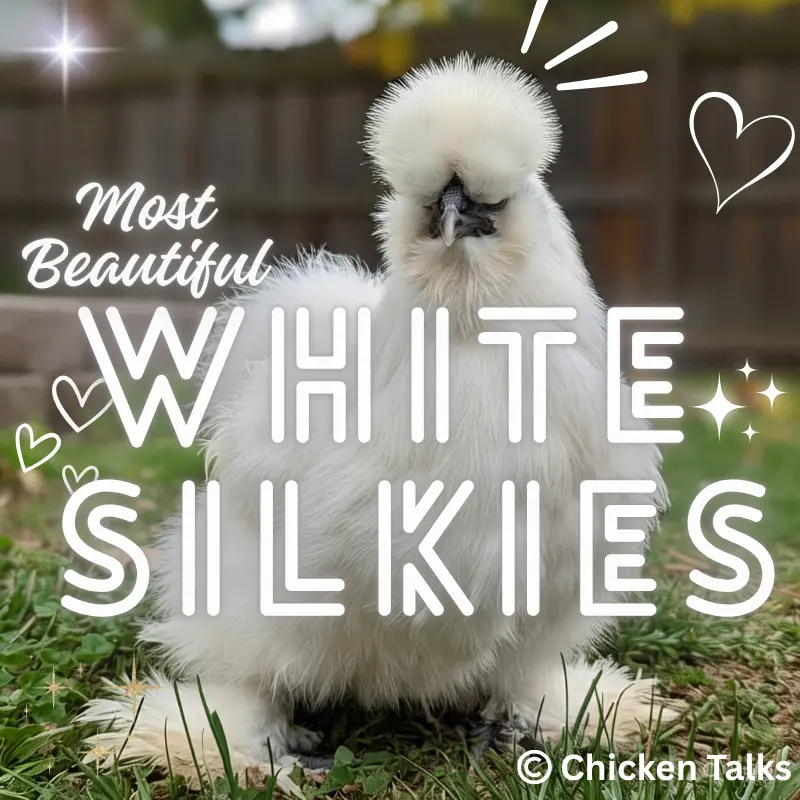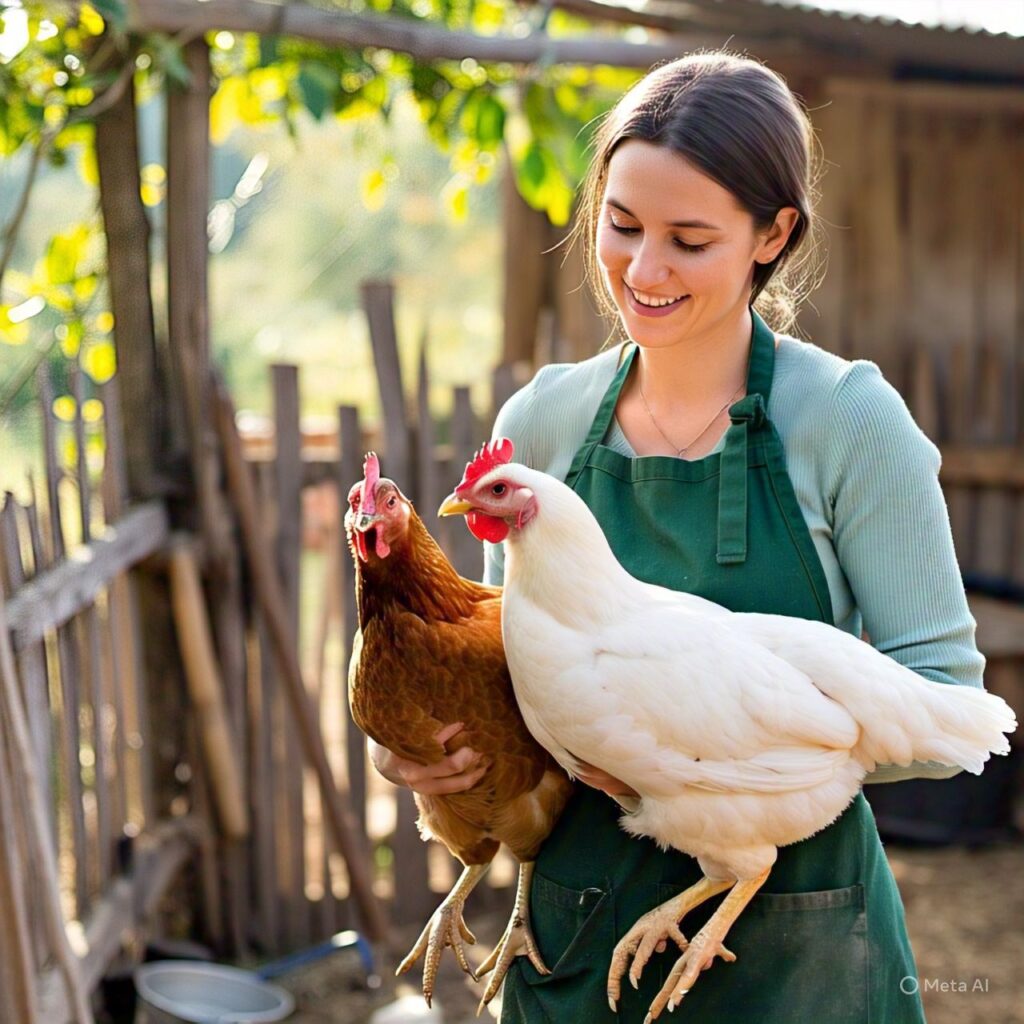Imagine a chicken that looks like it’s wearing a fancy white fur coat? That’s a White Silkie for you!
These fluffy little beauties are seriously addictive. Once you see one, you’ll probably want a whole flock. Their soft, silky feathers feel nothing like regular chicken feathers – it’s more like petting a rabbit.
Why are they so popular? Simple – they’re the teddy bears of the chicken world.
Kids love these gentle birds because they enjoy being cuddled. Try doing that with your average chicken! They will happily sit in your lap and let you stroke their fluffy feathers for hours.
What makes them beautiful? They’ve got five toes instead of four, black skin, and those adorable puffball heads that make them look perpetually surprised.
Sure, keeping their white feathers clean can be a bit of work. But honestly, watching these little fluff balls waddle around your yard is worth the extra effort. They’re perfect for anyone wanting chickens that are more like pets than just egg machines.
Ready to fall in love with the fluffiest chickens on earth?
Here is what we will discuss today.
Where Do White Silkies Come From?
White Silkie chickens originate from China, not Japan, as some think. This true bantam breed has been a standout for centuries with its unique barbless plumage that feels incredibly soft and fluffy.
What makes their appearance so special? These unusual chicken breeds available today are renowned for having black skin, extra toes, and blue earlobes – differentiating qualities that make them incredibly popular pets. Their docile nature is just perfect!
What Makes White Silkies So Special?
You know what’s crazy? This variety of Silkies is among the oldest chicken breeds on record – like, we’re talking generations of people falling in love with these weird little fluff balls.
I’ve been delighting poultry enthusiasts and backyard hobbyists with stories about them for years.
Here’s the thing that gets me every time – their pure white plumage lacks barbs. Touch one and you’ll see what I mean – it’s so fluffy and soft in comparison to normal chicken feathers. That crest of feathers on their head? Total pom-pom vibes!
But wait, there’s more weirdness. These highly unique birds rock 5 toes instead of 4 – truly bizarre physical features that make your Bantam flock visitors do double-takes. This trait defines the whole breed, plus they’ve got black skin color and bluish feet with blue earlobes.
Fun fact – in some countries, people eat their meat as a delicacy! Despite all this quirky appearance stuff and amazing heritage, the American Poultry Association does recognize them for showing thanks to their compact bodies.
Are White Silkies Bantam Size?
Silkies are fairly small chickens; therefore, they’re considered a true bantam chicken – a miniature version without any standard-sized breed counterpart. This makes them currently uncommon but adorable!
They’re recognized in the US and Canada as one of the friendliest breeds around. They are perfect for backyard farmers looking at feathery birds that are great with kids.
These little fluff balls are an excellent choice for families who want something special. Their tiny size and sweet personality have made them incredibly popular on the show circuit, too.
What Makes White Silkies Stand Out From Other Colors?
In the chicken world, people who choose to show their chooks in competition know it’s a serious sport with strict rules, regulations, and standards you must comply with.
Silkies come in multiple color varieties like White, Black, Blue, Splash, Buff, Partridge, but all must professionally adhere to the same standard for accepted overall breed characteristics.
White ones are just easier to keep clean for shows compared to darker colors!
Some Myths and Fun Facts About White Silkies
Here’s a crazy myth – people used to think Silkies were part rabbit! Yeah, seriously. Their fluffy feathers fooled folks back in the day into believing they were some weird chicken-bunny hybrid.
Fun fact time: Silkies have black bones and meat, which freaks out first-time owners. Don’t worry, though – it’s completely normal for the breed and doesn’t mean anything wrong with your birds.
What is the temperament of White Silkies?
Do you know what’s funny about these chickens? They act more like fluffy dogs than chickens! My neighbor’s kids carry theirs around like other stuffed animals, and the birds just love it.
These little birds are sweethearts and delicious friends – never pecky or nasty like some breeds can be. They’ll follow you around the yard hoping for treats and cuddles. Even with other chickens, they’re the peacekeepers who avoid all the drama.
Appearance of White Silkies
What Do White Silkies Look Like?
They mostly look like walking fluff bombs? Their feathers don’t work like normal ones – no barbicels or hook-like appendages to hold things together.
While regular chicken feathers have individual hairs that create a smooth, tidy shape when the chicken preens and smoothes its plumage, Silkies lack this system.
What happens instead? Their fluffy feathers grow in this crazy, untidy fashion that never lies flat against their bodies – think cotton balls with legs running around your yard! When touched, they feel like silk or satin rather than normal feathers.
The pure white feathers without barbs are incredibly soft in comparison to other breeds.
These highly unique birds have physical features that blow your mind – feathering extends down their legs, they boast 5 toes instead of 4, plus that crest atop their head creates a perfect pom-pom look.
Truly makes them the most impressive Bantam addition to any flock!
How Big Do White Silkies Get?
Don’t expect giant chickens here! A Silkie hen will weigh between 2 and 2.5 pounds (around 1.3kg) and stand about 8 to 10 inches (20 to 25 cm) tall. They’re seriously tiny!
Rooster boys get a bit bigger – usually hitting three to four pounds (1.8kg) with a height of 11 inches (about 27cm). Still pretty small though.
Honestly, their fluffy feathers make them look way bigger than they are. Remove all the extra stuff, and you’re left with a surprisingly small bird!
Do White Silkies Lay Decent Eggs?
They lay eggs, but don’t expect your breed to match standard commercial layers! They produce about three eggs per week – not exactly prolific layers compared to other birds.
Their eggs are small with off-white, cream, or ivory-colored shells that can be tinted depending on the individual bird.
The color might have some influence from their black skin, unlike blue, buff, or other varieties that look the same.
What’s nice about Silkie eggs? They’ve got large, deep yellow yolks that are firm with solid whites – good quality even if not long on quantity.
If you are looking for a deep dive into egg production, you’ll want to keep other breeds for serious laying!
What are the broodiness and Hardiness behavior of White Silkies?
They are famous for being broody! These girls will sit on anything – eggs, golf balls, even empty nests.
I’ve seen mine try to hatch a doorknob once, swear to God. They make amazing mothers and will adopt any chicks you give them, even from other breeds.
Now here’s the thing about hardiness – they aren’t exactly tough cookies. Their fluffy feathers get soaked in rain, and they can’t fly away from predators. You’ll need to baby them a bit more than regular chickens.
Cold weather? They handle it okay, thanks to all that fluff, but wet conditions are their kryptonite. Keep them dry, and they’ll be happy campers in your backyard flock.
How to breed White Silkies?
Breeding White Silkies are lovely and straightforward, fluffy birds- just pair a rooster with hens and let nature do its thing. These broody birds love sitting on eggs and make excellent mothers for hatching chicks.
To make sure your breeding stock is healthy, you must add good nutrition and clean coops. Their genetics are dominant, so you’ll get mostly white offspring when breeding true bloodlines.
Incubation takes 21 days, whether using a broody hen or an artificial incubator. Start with quality breeding pairs from reputable breeders for the best results.
Keeping White Silkies
What Are the Care and Housing Requirements of White Silkies?
As discussed earlier, their fluffy plumage isn’t waterproof like normal chicken feathers.
You’ll need shelter that keeps your flock warm and dry, somewhere that’s well-ventilated but not drafty. They need a good shelter from the rain — if they get wet and you’re not keeping an eye on them, they can get chilled and even risk dying.
Their feathers make roosts tricky since they can’t hop up high without hurting themselves. Those feathered feet need clean areas too – preening the feathering becomes a problem in cold, muddy areas exposed to snow.
Freezing and accumulating ice can lead to frostbitten toes, so they need to retreat from harsh weather and icy mud that creates gunk-like glue, causing discomfort, pain, and infections.
The coop must use good bedding like pine shavings or dust-free hemp. When you are planning a coop structure, allow 2 to 3 square feet (about 30 x 30 cm to 45 x 45cm) per chicken. For 7 to 8 chickens or more, a meter of space works better – your flock will own their area much happier.
A proper-sized run helps since they’re natural foragers who love to explore, though free-ranging isn’t advisable given their small stature.
Are White Silkies Good for Beginners?
They are incredibly popular backyard additions and one of the most common color varieties of this breed.
Regular Silkie chickens are a great addition to most flocks, but since they can’t fly, they’re not likely to make it out of a fenced suburban yard.
They’re beautiful and easygoing and usually adjust well to being kept in a coop — as long as there’s enough space for them, they’ll be content to wander around inside all day.
Start with 4 to 5 birds if roosters are allowed in your area – be wise about hens-to-rooster ratios, or boys will hurt each other.
Go with around one rooster per ten hens to avoid fighting – the girls appreciate company without large drama. You might want separate spaces for breeding pairs.
These poor layers but amazing mothers are notoriously broody – good idea to equip nesting boxes that feel safe and inviting for these motherly birds. One box per 3 to 4 hens is sufficient since they don’t mind sharing.
Gathering eggs can be a bit tricky when they start clucking and getting protective! They won’t damage gardens or be aggressive toward your veggie patch – give them a chance to chow safely!
Want to Learn More about Silkies Chicken Breed?
Here’s our article about Silkies chickens, in which we discuss all about them. In which we cover all these topics:
Why Are Silkies So Unique?
Are Silkie Chickens Suitable for Beginners?
How Many Colour Types of Silkie Chickens Are There?
Are Silkie Chickens Good with Kids?
What’s the Lifespan of a Silkie?


